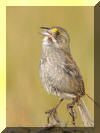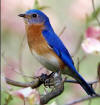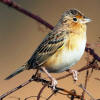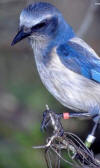Discover Florida Nature
It's time to explore the natural Florida


|
|
|
|
|
 Bachman's
Sparrow- The Bachman’s sparrow prefers open longleaf forests
with a groundcover of grasses or forbs, but with little or no understory
of trees or shrubs. Spring and summer is the best time to listen for the
elusive five-inch Bachman’s sparrow. Their song begins with a loud,
clear whistle followed by an extended trill. Its color is often
gray-brown and it has a long, dark bill and long, rounded tail. In the
spring, pregnant females scrape out a shallow depression on the ground
and then construct a domed grass nest in a dense shrub or palmetto
clump. Three to five glossy white eggs are laid, the young usually
hatching in late spring or early summer. After 10 days, the young leave
the nest. Bachman's
Sparrow- The Bachman’s sparrow prefers open longleaf forests
with a groundcover of grasses or forbs, but with little or no understory
of trees or shrubs. Spring and summer is the best time to listen for the
elusive five-inch Bachman’s sparrow. Their song begins with a loud,
clear whistle followed by an extended trill. Its color is often
gray-brown and it has a long, dark bill and long, rounded tail. In the
spring, pregnant females scrape out a shallow depression on the ground
and then construct a domed grass nest in a dense shrub or palmetto
clump. Three to five glossy white eggs are laid, the young usually
hatching in late spring or early summer. After 10 days, the young leave
the nest. Cape
Sable Seaside Sparrow- The Cape Sable seaside sparrow is the
only bird restricted entirely to the Everglades ecosystem. The
non-migratory Cape Sable seaside sparrow occurs almost exclusively in
Everglades National Park and Big Cypress National Preserve in Dade and
Monroe counties. The 5-inch-long sparrow is dark olive-gray and brown on
the back and light gray with dark olive streaks on the sides. It has
small patches of yellow feathers in front of the eyes and at the bend of
the wings. Because of their small size, drab appearance, and secretive
habits, seaside sparrows usually are heard before they are seen. The
male’s song consists of a few introductory notes followed by a “buzzy”
trill. Cape
Sable Seaside Sparrow- The Cape Sable seaside sparrow is the
only bird restricted entirely to the Everglades ecosystem. The
non-migratory Cape Sable seaside sparrow occurs almost exclusively in
Everglades National Park and Big Cypress National Preserve in Dade and
Monroe counties. The 5-inch-long sparrow is dark olive-gray and brown on
the back and light gray with dark olive streaks on the sides. It has
small patches of yellow feathers in front of the eyes and at the bend of
the wings. Because of their small size, drab appearance, and secretive
habits, seaside sparrows usually are heard before they are seen. The
male’s song consists of a few introductory notes followed by a “buzzy”
trill.  Cerulean
Warbler- Cerulean warblers are strikingly beautiful – adult
males are a vibrant blue color on their backs and heads, and white
below, with a dark breast band and dark streaks. Adult females are
blue-green above, pale yellowish below. As they fly between their
wintering areas in South America and nesting sites in the United States
and Canada, they alight only briefly in Florida, part of the migratory
songbird contingent that sweeps in waves over our state every spring and
fall. Cerulean
Warbler- Cerulean warblers are strikingly beautiful – adult
males are a vibrant blue color on their backs and heads, and white
below, with a dark breast band and dark streaks. Adult females are
blue-green above, pale yellowish below. As they fly between their
wintering areas in South America and nesting sites in the United States
and Canada, they alight only briefly in Florida, part of the migratory
songbird contingent that sweeps in waves over our state every spring and
fall.  Eastern
Bluebird- Bluebirds are small, beautifully colored thrushes.
They’re often seen perched in a hunched position on wires or fences in
fields and open woodlands throughout central and north Florida. The
adult male bluebird has a vibrant blue back, head and tail, chestnut
colored throat and breast, and white belly. Females are duller and
grayer and young birds are heavily spotted. During the summer, bluebirds
feed mainly on insects and earthworms. During the non-breeding season,
they form small flocks. When the weather is very cold, a group of
bluebirds will occasionally roost together in a nest cavity for warmth. Eastern
Bluebird- Bluebirds are small, beautifully colored thrushes.
They’re often seen perched in a hunched position on wires or fences in
fields and open woodlands throughout central and north Florida. The
adult male bluebird has a vibrant blue back, head and tail, chestnut
colored throat and breast, and white belly. Females are duller and
grayer and young birds are heavily spotted. During the summer, bluebirds
feed mainly on insects and earthworms. During the non-breeding season,
they form small flocks. When the weather is very cold, a group of
bluebirds will occasionally roost together in a nest cavity for warmth.  Florida
Grasshopper Sparrow-
Florida grasshopper sparrows are small, short-tailed birds, about 5
inches long and weighing less than one ounce. This not so drab sparrow
is mostly black and gray with some brown streaks on the back.
Underneath, it is light gray or buff color with no streaking. Feathers
at the bend of the wing are bright yellow and there is an orange patch
in front of the eyes. A white stripe marks the top of the head. The
male’s primary song is weak and grasshopper-like, giving rise to the
bird’s common name. Florida
Grasshopper Sparrow-
Florida grasshopper sparrows are small, short-tailed birds, about 5
inches long and weighing less than one ounce. This not so drab sparrow
is mostly black and gray with some brown streaks on the back.
Underneath, it is light gray or buff color with no streaking. Feathers
at the bend of the wing are bright yellow and there is an orange patch
in front of the eyes. A white stripe marks the top of the head. The
male’s primary song is weak and grasshopper-like, giving rise to the
bird’s common name. Florida
Scrub-Jay-
The Florida scrub-jay is a 12-inch-long, blue and gray crestless jay
that lacks the white wing spots and tail feather tips of the more common
and widespread blue jay. A necklace of blue feathers separates the
whiter throat from the gray whitish forehead. The tail is long and loose
in appearance, and the back is gray. Scrub-jays that are less than about
5 months old can be identified by their dusky brown head and neck, but
there are no such physical traits that distinguish males from females. Florida
Scrub-Jay-
The Florida scrub-jay is a 12-inch-long, blue and gray crestless jay
that lacks the white wing spots and tail feather tips of the more common
and widespread blue jay. A necklace of blue feathers separates the
whiter throat from the gray whitish forehead. The tail is long and loose
in appearance, and the back is gray. Scrub-jays that are less than about
5 months old can be identified by their dusky brown head and neck, but
there are no such physical traits that distinguish males from females. Painted
Bunting- The painted bunting is one of the most rapidly
declining songbirds in the eastern United States. Florida breeding and
winter season surveys show an astounding 4-6 percent annual decrease in
this species' numbers. In some areas, counts have fallen from the
hundreds to a mere handful. Painted buntings are medium-sized and
gloriously colored: males are blue, red, yellow and green, females a
greenish yellow. The buntings seek brushy vegetation in open areas such
as roadside thickets and edges of fields. They frequent backyard
gardens, searching for seeds. They nest in the shrub edges in coastal
hammocks. Painted
Bunting- The painted bunting is one of the most rapidly
declining songbirds in the eastern United States. Florida breeding and
winter season surveys show an astounding 4-6 percent annual decrease in
this species' numbers. In some areas, counts have fallen from the
hundreds to a mere handful. Painted buntings are medium-sized and
gloriously colored: males are blue, red, yellow and green, females a
greenish yellow. The buntings seek brushy vegetation in open areas such
as roadside thickets and edges of fields. They frequent backyard
gardens, searching for seeds. They nest in the shrub edges in coastal
hammocks. Wood
Thrush- The song of the wood thrush is so beautiful it inspired
Handel to write a piece of music in the bird's honor. There is no more
lovely a sound than the loud, flute-like song, ending in a trill, of
this songbird. The wood thrush is large and plump, reddish-brown above
and whitish below, with large dark spots on its throat, breast and
sides. It has a bold, white eye ring and its tail is short. It is often
tied to shade-grown coffee plantations in South America for winter
survival, since it requires shady areas. Spring brings it returning to
North America to breed in moist deciduous forests. Wood
Thrush- The song of the wood thrush is so beautiful it inspired
Handel to write a piece of music in the bird's honor. There is no more
lovely a sound than the loud, flute-like song, ending in a trill, of
this songbird. The wood thrush is large and plump, reddish-brown above
and whitish below, with large dark spots on its throat, breast and
sides. It has a bold, white eye ring and its tail is short. It is often
tied to shade-grown coffee plantations in South America for winter
survival, since it requires shady areas. Spring brings it returning to
North America to breed in moist deciduous forests. |
|
|
Advertise | Privacy Statement | Dog Encyclopedia | Video |Contact | Alaska Nature |
|